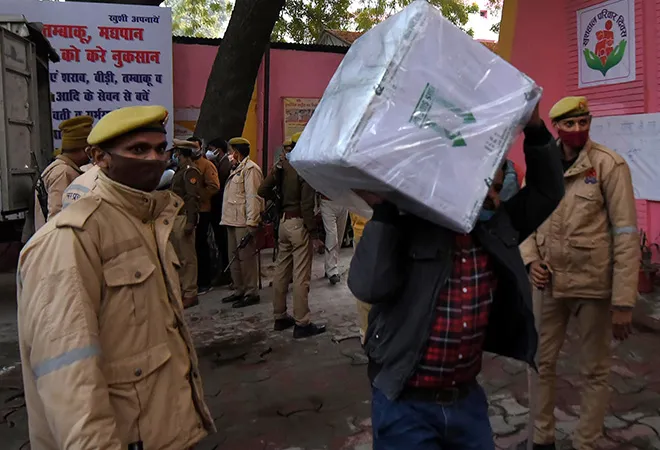
This is part of the weekly series assessing the COVID-19 vaccine rollout in India and the world.
This week roughly 40.8 million COVID-19 inoculations were conducted in the world. As of now, the COVID-19 vaccine campaign has observed more than 173 million doses being administered globally, across 77 countries.
The average daily rate of doses administered increased from 4.68 million to 5.96 million in the past week. This increase has further reduced the rate for covering 75 percent of the global population with a two-dose vaccine to approximately 5 years from the 6.7 years (as of 7th February) estimated by the Bloomberg COVID-19 Vaccine Tracker. The steady rise in inoculations coupled with consistent research into new vaccines and protective measures, promises a positive future.
Currently, there are 67 vaccines under clinical trials and at least 89 are in the pre-clinical investigation stages. 20 vaccine candidates have reached the final phases of testing in large-scale vaccine efficacy trials, while only 4 vaccines have been approved for full use, namely—Pfizer-BioNTech, Moderna (both Pfizer and Moderna were fully approved in Bahrain, Saudi Arabia, and Switzerland, but are in emergency use in US, EU, and other countries), Sinopharm (approved in China, U.A.E., Bahrain), and Sinovac (conditional approval in China).
On the other hand, vaccines such as Gamaleya Sputnik V (early use in Russia, emergency use in other countries), Oxford-AstraZeneca (emergency use in UK, EU, and other countries), Bharat Biotech’s Covaxin (emergency use in India), CanSino (limited use in China) have received limited emergency approval. The coming weeks are expected to witness the approval of at least 2 vaccine candidates,namely—the Novavax vaccine and the Johnson & Johnson vaccine, that have shown 89.3 percent and 66 percent efficacy, respectively.
Figure 1: Global COVID-19 vaccine Trend
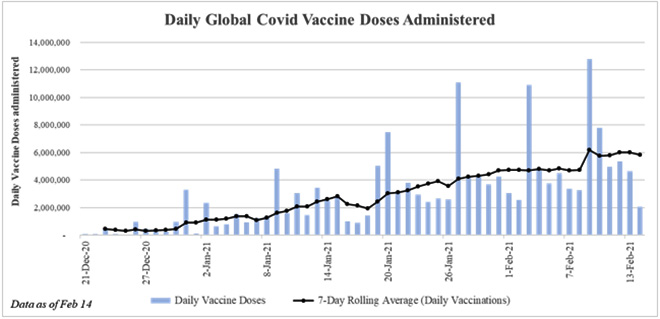 Source: Our World in Data
Source: Our World in Data
Presently, the COVID-19 vaccine drive is led by the United States, with more than 53 million doses administered, as of 14th February, followed by China (40 million), UK (15 million), and India (8.2 million). While USA and China lead in absolute doses administered, Israel’s inoculation surpasses that of other countries with 70 doses administered for every 100 people. USA and China seem to be lagging behind with 16.3 and 2.8 doses per 100 population, largely attributed to the high population base.
Figure 2: Country-wise COVID-19 vaccine doses administered
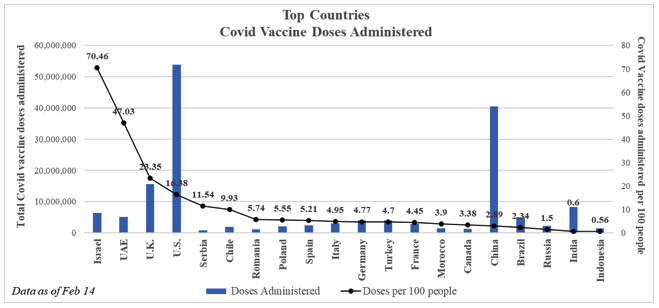 Source: Bloomberg Vaccine tracker
Source: Bloomberg Vaccine tracker
India’s COVID-19 vaccine update
India’s total confirmed cases have surpassed 10.9 million, with an increase of 77,346 cases in the past week. Recoveries in India saw an increase to 10.6 million, while 91 COVID-19 deaths were reported in the past 24 hours, taking the total to 155,771. Since last week, the 7-day average of COVID-19 deaths in India has fallen from 98 to 92.
India’s COVID-19 vaccination journey commenced on 16th January, 2020 with 2 major vaccines, namely—the SII-Oxford-Astrazeneca Covishield vaccine and the Bharat Biotech-ICMR Covaxin vaccine. On the first day of its vaccine drive, India administered 191,181 doses. India initiated the second dose on completion of the first four weeks of its vaccination drive; however, only 23,628 healthcare workers were noted to have received the second dose—a mer one out of ten of the first day batch. The Indian government’s early approval of Bharat Biotech’s Covaxin—while the vaccine is still in its phase-3 of clinical trials—continues to brew tension amongst front line and health care workers, who have been refusing the vaccine.
Nevertheless, India has successfully administered more than 8.2 million doses, making India the fourth highest country in terms of total vaccine doses administered. In the past week alone, India saw 2.4 million inoculations. India’s average daily vaccination rose from 267,675 doses last week to 285,700 this week. The weekly average of vaccinations also saw a rise of 20 percent from the week ending on 7th February till the week ending on 14th February. The below figure shows India’s consistent daily vaccine coverage, with a steep fall seen on the weekends due to closure of most government facilities.
Figure 3: COVID-19 vaccine trends in India
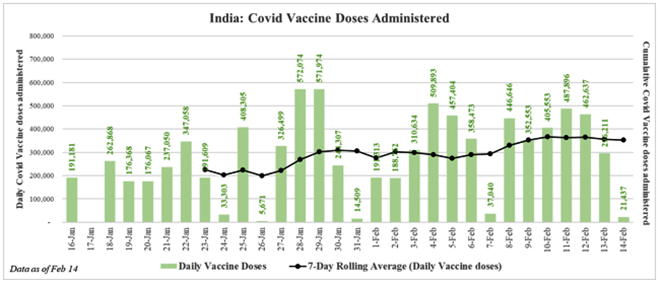 Source: Ministry of Health and Family Welfare, Government of India
Source: Ministry of Health and Family Welfare, Government of India
Uttar Pradesh continues to lead the country with 858,602 doses administered, while Union Territories—Lakshadweep and Ladakh—lag with 1,776 and 2,981 doses administered, respectively. However, when closely observing the vaccine stats, Lakshadweep leads with 24.3 doses administered per 1,000 people. On an overall level, India has administered 6 doses for every 1,000 people.
Figure 4: COVID-19 vaccine trends in Indian states
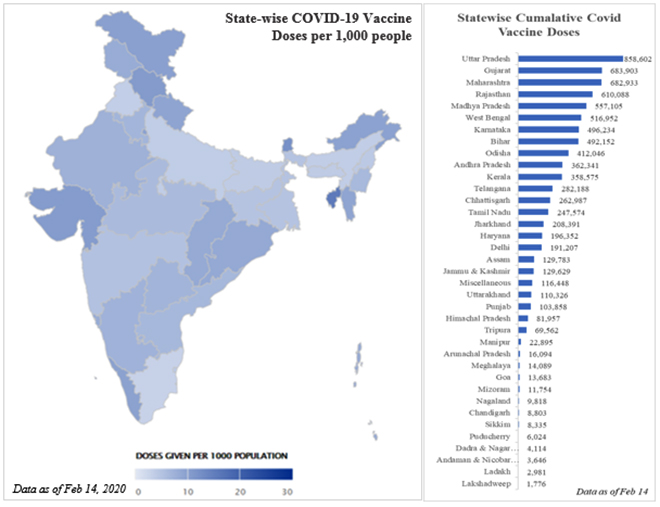 Source: Observer Research Foundation Vaccine Tracker
Source: Observer Research Foundation Vaccine Tracker
With the immunisation drive underway, India is also working towards the development of seven COVID-19 vaccines, in an effort to reach each citizen of the country. At the moment, only health care and front-line workers are being vaccinated and closely monitored, to ensure that the vaccines are safe for use in the open market. India is set to begin the next phase of vaccinating people aged 50 years and above in March.
Table 1: Ongoing vaccine trials in India
| Phase |
Vaccine |
No. of Doses |
Start date |
Estimated Primary completion date |
| Phase III |
Bharat Covaxin |
2 |
25/11/2020 |
30/06/2021 |
| Phase II/III |
Gamaleya Gam-COVID-Vac/Sputnik V |
2 |
30/11/2020 |
30/08/2021 |
| Phase II/III |
Oxford ChAdOx1-S |
2 |
24/08/2020 |
24/03/2021 |
| Phase I/II |
Zydus Cadila ZyCoV-D |
3 |
13/07/2020 |
13/07/2021 |
| Phase I/II |
Bharat Covaxin |
2 |
13/07/2020 |
30/06/2021 |
| Phase I/II |
Biological E Ltd BECOV |
2 or 3 |
16/11/2020 |
16/01/2022 |
| Phase I/II |
Bharat Covaxin |
2 |
8/9/2020 |
8/5/2021 |
Source: Covid-19 Vaccine Tracker
Way forward
This week observed 4 new countries initiating their vaccine drives. Since the inception of the global vaccination campaign, a somewhat worrying trend has been observed in terms of unequal access to the vaccine. Even with emergency approvals and many countries racing to vaccinate their at-risk populations, only 77 countries have begun any kind of vaccination drives with seven vaccines available for public use.
With the first batch of Pfizer vaccine doses received today, Australia aims to initiate the rollout of the COVID-19 vaccine campaign by next week. African countries continue to lag behind with ~5-6 percent of their population covered by the current vaccine contracts. Inequitable access along with the lack of logistical efficiency in vaccine delivery seem to be the biggest roadblock as countries move forward.
After almost two months of the ongoing vaccination campaign, mostly high-income countries have been able to secure vaccine contracts and initiate the vaccination drives for their population. In contrast, lower-middle-income and low-income countries have hardly even started vaccinating their vast populations. Over the last week, there was a meagre 1 percent rise in the distribution of vaccine doses in lower-middle-income countries, whereas low-income countries are yet to begin their vaccination drives.
Figure 5 shows the lack of equity in vaccine distribution globally, wherein no low-income country has begun its vaccination drive.
Figure 5: COVID-19 vaccine inequitable coverage
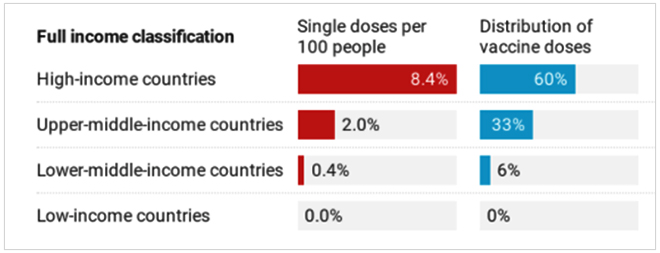 Source: PandemIC Vaccine Equity Tracker, 14th February 2021
Source: PandemIC Vaccine Equity Tracker, 14th February 2021
India: the pharmacy of the world #VaccineMaitri
Amid worldwide controversy sparked by the vaccine diplomacy efforts, India has presented and prepared itself to aid the global pandemic recovery efforts. Pre-COVID-19 India was a supplier of 60 percent of the world’s vaccines.
It has been predicted that India will be the second largest COVID-19 vaccine maker, with the aim of producing 3.5 billion doses in 2021, second to USA’s 4 billion production estimates. Indian firm Bharat Biotech, along with the Indian Council of Medical Research, aims to increase the vaccine production capacity of Covaxin to 700 million this year. Furthermore, the Oxford-AstraZeneca vaccine produced by the Serum Institute of India (SII), that produces 50 million doses monthly, will be expanding to 100 million by March end.
India has already rolled out approximately 23 million doses of COVID-19vaccines to 20 countries, out of which 6.47 million were grants and 16.5 million were commercial supplies. Yesterday itself, Mexico has received 1 million Indian produced COVID-19 vaccine doses. India aims to further aid African and Latin American countries in the coming days.
While there has been some apprehension regarding the low turnout for the second dose of the COVID-19 vaccine, it is important to report facts, and unfortunately that has not been the case. International studies show that the second dose of the Covishield and Covaxin are most effective when given in a 6-12 week window of the first dose. India’s current policy has been advising a 4-week window; however, this is not a mandatory requirement. Therefore, the fall in the inoculations on 13th -14th February does not necessarily translate into a 'rejection' of the vaccine by the health workers, or a decline in its effectiveness. It also needs to be kept in mind that India has a history of low vaccine rollout on the weekends. The next 2-4 weeks will be very crucial to judge the impact and reception of these vaccines within the Indian medical community.
The views expressed above belong to the author(s). ORF research and analyses now available on Telegram! Click here to access our curated content — blogs, longforms and interviews.




 Source:
Source:  Source:
Source:  Source:
Source:  Source:
Source:  Source:
Source:  PREV
PREV


